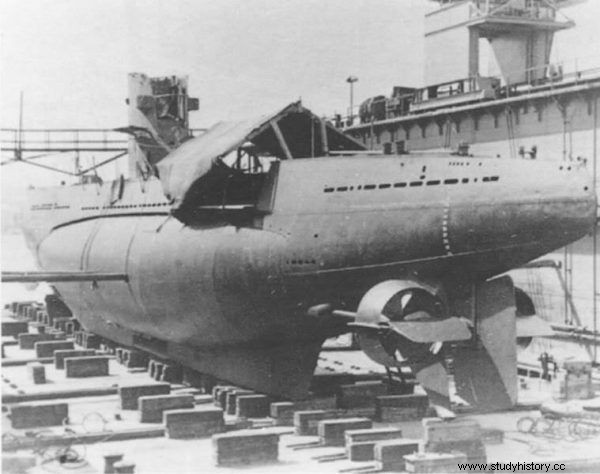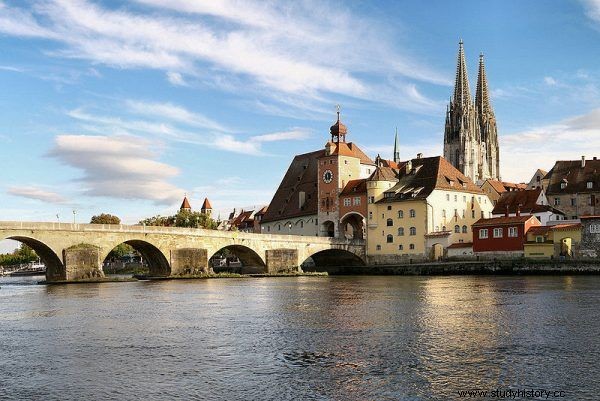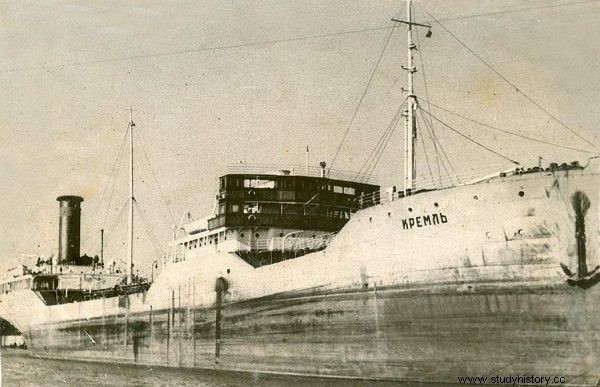The German Kriegsmarine during the war carried out an unusual and very complicated transport and logistics operation. It has transferred six submarines and over 100 other vessels from the Baltic Sea to the Black Sea. Floating? Probably not entirely, because the transport took place first by rivers, and then ... by roads! The ships traveled on the freeway on wheels at a lethal speed of 8 km / h
On June 22, 1941, the Third Reich attacked the Soviet Union. According to the assumptions of Adolf Hitler, the purpose of the operation code-named "Barbarossa" was to defeat Bolshevism and gain "living space" for the Germans. Three German army groups were attacking in three directions:on the northern section of the front - on Leningrad, on the central section - on Smolensk and Moscow, and on the southern section - on Kyiv and further on the Crimea.
The German offensive in 1941 was fought with varying luck. Near Leningrad and Moscow, the Wehrmacht was arrested, but in the south it penetrated deep into the territory of the USSR. In September, the 11th Army cut off the land connection with Crimea, and in the fall it occupied most of the Crimean peninsula. The Germans and the Romanians fighting on their side did not manage to capture only the heavily fortified city of Sevastopol. The siege of the city lasted from October 1941 to July 1942, which finally ended with the surrender of the Russians.
German confusion
Sevastopol was (and still is) an important port city on the Black Sea (since March 2014 occupied by Russia - editor's note). It includes, among others great naval port. However, in 1942 the conquerors of Sevastopol had little use from the port, because they had no ships of their own in the Black Sea. The Russians evacuated or sank their units and now the wind was blowing in the port and the Soviet Navy ruled the sea.

U-18 brought back to life in the port of Gałacz
However, the Germans had good planners who worked on solving the problem from the spring of 1942.
Considering the still unbroken combat strength of the Russian Black Sea Fleet, it is of particular importance that the light naval forces that will be transferred to the Black Sea become ready as soon as possible
- announced the OKW (Oberkommando der Wehrmacht) in the directive of April 5, 1942.
However, the matter was not as simple as it seemed OKW, because it was virtually impossible to transport the ships to the Black Sea by sea. First, ships from ports in northern Germany would have to sail across Europe, across the Strait of Gibraltar, vigilantly guarded by the Royal Navy, and then across the entire Mediterranean Sea. The further route would run through the Bosphorus and Dardanelles and this was where the biggest problem arose, because these straits were guarded by Turkey, which during the Second World War was neutral. Therefore, in order not to irritate the Western Allies, the Turkish government announced that it would not allow German ships to enter the Black Sea. (He had let Italian ships in there earlier, but that's a different story).
So the Germans had a serious problem, but - because warships were really needed in the Black Sea - they found a solution. A plan was drawn up for an extremely complicated, long, costly and dangerous operation to transport ships in rivers from the North Sea as far inland as possible. In the next stage, they were to cover several hundred kilometers by road - driving on a freeway on wheels. Later, they were to be dumped into the waters of the Danube and reach the mouth of this great river, to start combat operations from the Romanian port of Constanţa on the Black Sea after the engines and equipment were reinstalled.
On the surface, everything seems simple, but it was not about recreational motorboats, or even the sailing yachts that are sometimes towed on trailers. It was mainly about submarines. The Kriegsmarine chose the smallest type IIB u-boats for transfer to the Black Sea. However, "the smallest" does not mean "small" at all. Their length was 41 meters and their weight was about 250 tons! Only after removing the equipment, the ship weighed from 112 to 138 tons, which allowed it to be transported on barges and wheeled trailers.
A breakneck operation
Six submarines stationed in Gotenhafen, i.e. in occupied Gdynia, were assigned for the operation. These were U-9, U-18, U-19, U-20, U-23, U-24, which were ordered to ferry to Kiel. In the shipyard, they were gutted out of whatever they could - the most heavy elements of equipment were removed:internal combustion and electric engines, rudders and propeller shafts as well as very heavy battery batteries. Kiosks, i.e. superstructures of ships that would interfere with transport, were also dismantled.
The ships were turned 90 degrees, placed on the side and in this position placed on specially constructed shoulders with high carrying capacity. They were towed through the Kaiser Wilhelm Canal (now the Kiel Canal) and then up the river Elbe (through the middle of Germany) as far as Dresden. The most difficult stage of the operation began there - land transport. The ships were mounted on four 16-wheeled chassis. The most powerful Kaelble tractor units available at that time, on Culemeyer trailers, hauled them along the roads and motorways to the Danube, near Ingolstadt.

Bridge in Regensburg
This section is "only" 400 km long, but it is full of bends, climbs and descents, especially in the mountain sections. The operation was also hampered by 150 bridges under which "ships on wheels" had to pass. The towing tractors were driven side by side, if the conditions allowed, and if the road was narrower - one after the other. An additional assist tractor was driving in the rear and pushed the entire road train.
The average transport speed was 8 km per hour, and although disasters and damage to the cargo were avoided, transport was a real chore for drivers, maintenance and road tractors. The transported ships were accompanied by 43 trailers, fuel tanks, mobile workshops and buses for transporting personnel. The technical team consisted of 600 people!
After reaching the bank of the Danube, the ships were transferred to barges again and the river stage began. Ships across Regensburg (a complicated passage under a 12th-century stone arch bridge), Linz, Vienna, Budapest, Novi Sad and Belgrade reached the river shipyard in Gałacz, Romania, where they were restored to swim within 45 days. They sailed from Gałacz by sea to Constana, where technical and repair teams were waiting, whose task was to restore the combat capability of the ships.
An additional issue was to keep the entire operation secret, so that the ships traveling on the roads would not be detected and bombed by the Allied air force. At the road stage, the hulls of the U-boats were covered with tarpaulins to hide their characteristic shape. In turn, at the Danube stage, they swam between two barges, making them difficult to see from the shore.
Success
The operation of transporting six submarines from Germany to the Black Sea lasted almost a year - from mid-1942 to mid-1943. Transporting only one ship took six weeks. The route was over 2,500 kilometers long!
The U-boats transported to the Romanian port of Constanţa became part of the Black Sea 30th Flotilla. (30. Unterseebootsflottille). The U-24 was the first to be operational (October 10, 1942), and the last to go to sea the U-23 (June 3, 1943). The first combat attack was carried out on November 5, 1942 by the U-24 under captain Klaus Petersen. During this operation, the torpedo fuse failed and the Soviet tanker was only slightly damaged.

U-9 at sea
The ships based in Constanţa were coastal type, in maritime slang they were called "Einbaum" or dugout. They could reach speeds of 13 knots on the surface and 7 knots when submerged. The operational range was 3,100 nautical miles on the surface and up to 45 nautical miles under water. They could descend up to 150 meters. They were armed with three 53.3 cm torpedo tubes in the bow and a 2 cm light anti-aircraft gun on board.
Two of the Black Sea U-boats (U-9 and U-24) were equipped with top-secret armament of a new type. In the absence of the crew, rocket launchers, which are nowadays referred to as "water-to-ground" rockets, were installed below the waterline (they were therefore invisible from the shore - editor's note). These rockets could be launched from under the water and destroy land-based targets.
Technically, they were similar to the Schwerer Wurfrahmen 40 missiles used by the Germans, called "wardrobe" or "cow" in the Warsaw Uprising. U-9 carried out several operations with these missiles, bombing Soviet positions on land. In October 1943, a ship damaged in an air raid entered the port of Sevastopol for repairs. It was one of the few cases where a German ship was based in this hard-won city.
The successful land transport of u-boats prompted the Germans to transfer other vessels in a similar way. However, they were slightly smaller, and thus easier to transport. In total, 10 Schnellboots and 23 Räumboots, 50 ferries, 30 tugs, 4 dredgers, 2 icebreakers and over 150 other vessels were shipped to the Black Sea.
Effects commensurate with the effort?
As with other major German military operations, the performance of the Black Sea u-bot fleet was meager. In total, they sank only 12 Soviet vessels with a capacity of 45 426 GRT. The best combat result was achieved by the U-20, which sank 5 ships, including the moped "Kremlin".
The U-18, on the other hand, fired a lot of torpedoes, but almost all of them missed the target. Fortunately, on June 6, 1944, the ship finally achieved success - a pontoon drifting at sea was shot into pieces with an on-board machine gun.

Soviet moped Kremlin sunk by U-20
The fate of the submarines was completed in the port of Constana. From 1944, the Red Army on all fronts moved forward unstoppably, seizing successive territories and countries. Faced with the inevitable arrival of the Soviets, the Romanian government decided to change the front by 180 degrees and declared war on his former ally - Germany. It happened on August 25, 1944.
Earlier, on August 20, 1944, Soviet bombers sank U-9 in port and seriously damaged U-18 and U-24. On August 25, when it became known that the u-boats were stationed in the enemy port, the German crews decided to sink two damaged ships. In turn, U-19, U-20 and U-23 escaped from Constana to the sea. A few days later, they were sunk by crews off the coast of Turkey (the sailors went ashore and were captured). In early 2008, the seabed wrecks of these three sunken u-boats were found by a search team of Turkish underwater archaeologists.
